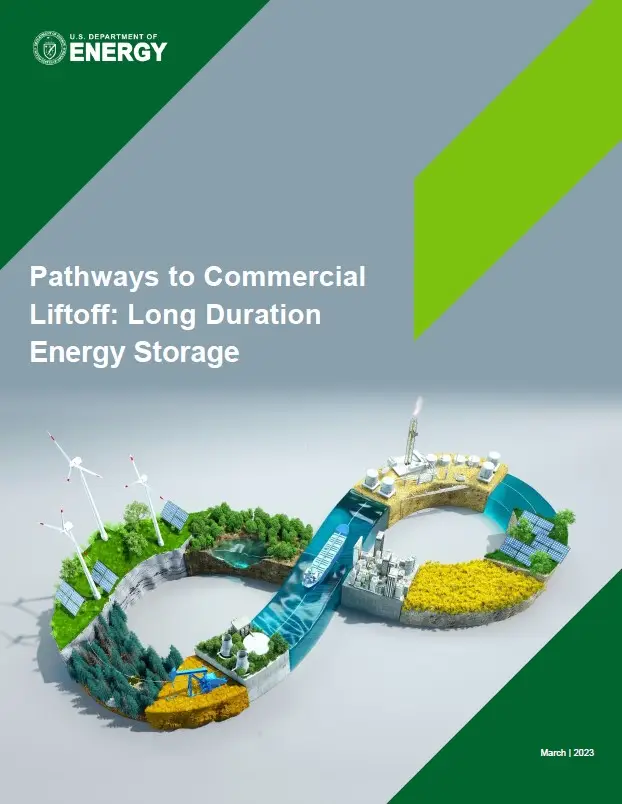This is an excerpt from the executive summary of a report, “Pathways to Commerical Liftoff: Long Duration Energy Storage,” prepared as an account of work sponsored by the U.S. Department of Energy. This report shows the huge potential hydrogen energy has within the near future.
“These Pathways to Commercial Liftoff reports aim to establish a common fact base and ongoing dialogue with the private sector around the path to commercial liftoff for critical clean energy technologies. Their goal is to catalyze more rapid andcoordinated action across the full technology value chain.
Introduction to LDES
To answer emerging environmental and social challenges as well as meet the Biden administration’s targets for 2050 Net Zero emissions and 100% carbon pollution free electricity by 2035, the power sector will need to rapidly scale and transition. Currently, the power sector is responsible for one third of domestic emissions. Successfully decarbonizing requires a transition away from uncontrolled fossil-fuels-based generation assets towards carbon-free power sources such as renewables (e.g., wind, solar) and nuclear. The power sector will need to simultaneously transition to new power sources and scale rapidly to meet new electrified downstream uses. As variable renewables cannot be turned on and off to meet peak demand in the same manner as fossil-fuels-based generation assets, the grid will need a new way of providing flexibility and reliability.
New options, like Long Duration Energy Storage (LDES), will be key to provide this flexibility and reliability in a future decarbonized power system. LDES includes a set of diverse technologies that share the goal of storing energy for long periods of time for future dispatch. The form of energy that is stored and released, as well as the duration of dispatch is highly variable across technologies.
This report focuses on the application of LDES systems for electricity purposes (e.g., energy is stored and then dispatched in the form of electricity at a later time). To evaluate the commercial feasibility of LDES within the U.S., this effort consulted a wide range of existing research1 and modeled a U.S. power sector decarbonization pathway with varied decarbonization and technical scenarios to assess LDES’s role in the power sector and factors influencing LDES deployment pathways for electricity needs. The integrated modeling scenarios serve three purposes:
- Estimating a business-as-usual trajectory: The business as usual (BAU) scenario represents the current trajectory and includes the impacts of the 2022 Inflation Reduction Act (IRA) but without additional commercialization interventions.
- Forecasting least-cost pathways to meet decarbonization goals: Net zero decarbonization scenarios forecast what it would take to reach net-zero by 2050 under different constraints on variable renewables and on transmission capacity. We forecast scenarios both with and without achieving interim clean power by 2035.
- Exploring technology potential: Technology specific sensitivities represent conditions for the uptake of different types of LDES under different operating parameters and competing technology conditions (e.g., net zero without LDES).
Based on this analysis, the U.S. grid may need 225-460-GW of LDES capacity for power market application for a net zero economy by 2050, representing $330B in cumulative capital. While this requires significant levels of investment, analysis shows that by 2050 net zero pathways that deploy LDES result in $10 20Bi in annualized savings in operating costs and avoided capital expenditures compared to pathways that do not (by 2050). The focus of this commercialization effort is to understand the challenges, solutions, and potential long run benefits of LDES achieving technology “liftoff” by 2030. “Liftoff” is defined as the point where the LDES industry became a largely self-sustaining market that does not depend on significant levels of public capital and instead attracts private capital with a wide range of risk. “Liftoff” is characterized by significant improvement in technology and operating parameters, market recognition of LDES’s full value, and realization of industrial scale manufacturing and deployment capacity. These improvements are needed for LDES to compete with alternative technologies.”
For a PDF of the complete “Long Duration Energy Storage” report, Click on this Link to the U.S. Department of Energy website. The PDF download link is at the bottom of their webpage.


